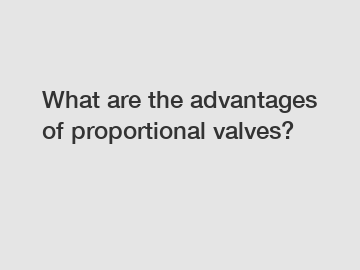What are the advantages of proportional valves?
What are the advantages of proportional valves? Proportional valves offer several benefits in various industries, ranging from manufacturing to automotive and aerospace. These valves allow for precise control of fluid flow, pressure, and direction, resulting in improved efficiency, accuracy, and performance in hydraulic and pneumatic systems.
One of the main advantages of proportional valves is their ability to provide precise flow control. Traditional on/off valves can only allow full flow or no flow, which can lead to inefficiencies and compromised system performance. In contrast, proportional valves can adjust the flow rate according to the specific requirements of the system, ensuring optimal operation and reducing energy consumption.
Proportional valves also offer accurate pressure control, which is essential in many applications. By regulating the pressure within a hydraulic or pneumatic system, these valves enable consistent and stable performance, preventing damage to components and enhancing the overall safety of the system. This feature is particularly crucial in industries where precision and reliability are paramount, such as aerospace and medical equipment manufacturing.

Furthermore, the directional control provided by proportional valves greatly enhances the flexibility and versatility of hydraulic and pneumatic systems. These valves can quickly and precisely change the direction of fluid flow, enabling machines and equipment to perform complex movements and functions. This is especially beneficial in industries where precise and coordinated motion control is crucial, including robotics, automation, and material handling.
The advantages of proportional valves stem from their innovative design and advanced technology. These valves incorporate a feedback mechanism that continuously monitors and adjusts the valve position to maintain the desired flow, pressure, or direction. This feedback loop ensures accurate and responsive control, even in dynamic and changing operating conditions.
The significance of proportional valves lies in their contribution to improving overall system efficiency, accuracy, and performance. By optimizing fluid control, these valves minimize energy consumption, reduce wastage, and extend the lifespan of system components. This not only leads to cost savings but also enhances system reliability and productivity, benefiting industries and end-users alike.
Moreover, the widespread adoption of proportional valves has had a significant impact on various industries. Their precise control capabilities have allowed for the development of more advanced and sophisticated machinery and equipment. From high-speed manufacturing processes to precise motion control systems, proportional valves have become a crucial component in modern industrial applications.
In conclusion, the advantages of proportional valves encompass precise flow control, accurate pressure regulation, and flexible directional control. These valves have revolutionized hydraulic and pneumatic systems, offering improved efficiency, accuracy, and performance in various industries. With their innovative design and advanced technology, proportional valves play a pivotal role in enhancing system reliability, productivity, and overall industrial progress.
If you are looking for more details, kindly visit Superimposed Relief Valve, hydraulic one way valve, How does directional solenoid valve work.


